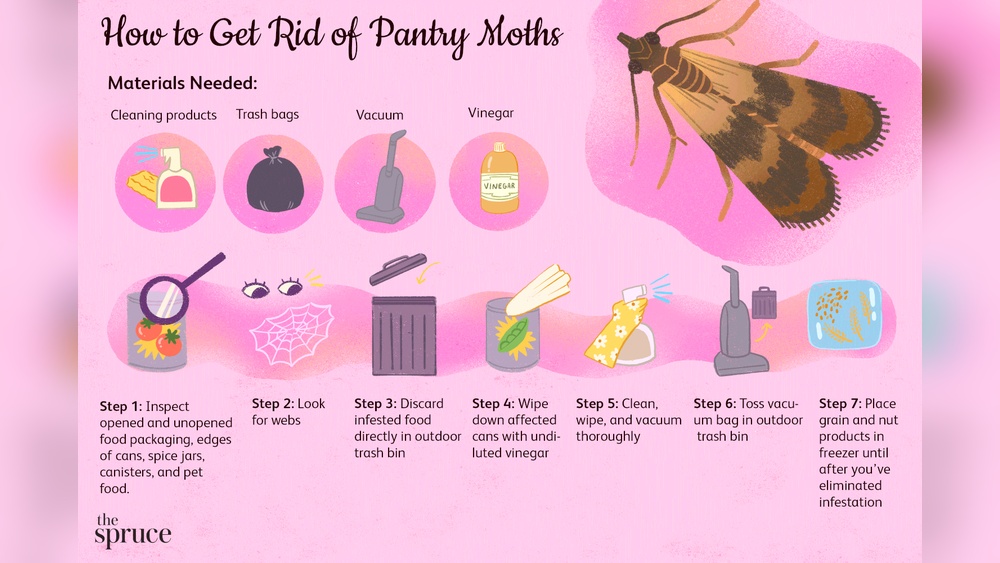Are you noticing tiny moths fluttering around your kitchen cupboards? Those pesky pantry moths can quickly turn your cooking space into their feeding ground, contaminating your flour, cereals, and spices.
If you want to stop these unwanted guests from ruining your food and peace of mind, you need to act fast and smart. In this guide, you’ll discover simple, effective steps to get rid of moths in your kitchen for good.
Keep reading to protect your pantry and enjoy a moth-free kitchen!

Common Pantry Moths
Common pantry moths found in kitchens include Indian meal moths and Mediterranean flour moths. These moths infest dry food items like flour, cereal, pasta, and spices. They enter homes mainly through infested food packages bought from stores. Moths also fly in through open doors, windows, and small gaps around vents and pipes.
Adult moths lay eggs on stored food. The eggs hatch into larvae, which feed on the food and cause damage. This makes the food look dusty or webbed. Larvae can be hard to spot because they hide inside the food.
Keeping food in airtight containers helps stop moths from accessing it. Regularly checking and cleaning the pantry reduces the chance of moth invasion. Prevent moths by sealing entry points like cracks and vents around your kitchen.

Reasons For Infestation
Pantry moths enter kitchens mainly through contaminated food. Bags of flour, cereal, pasta, and spices often carry moth eggs or larvae. This is the most common way moths infest a kitchen.
They also come through entry points like open doors, windows, and small gaps near vents or cables. These openings let moths easily fly inside.
Dry goods attract female moths because they lay eggs on these foods. Flour, cereals, pasta, and grains serve as perfect places for their young to grow.
Identifying Moth Presence
Signs in Food Packages include small holes or tears in bags. You might see webbing or sticky clumps inside boxes. Larvae often leave powdery dust or silk threads on food surfaces.
Larvae and Web Indicators appear as tiny, worm-like creatures. They spin fine silk webs that can clump food together. These webs are a clear sign of infestation.
Moth Activity Areas focus on dark, undisturbed corners of the pantry. They prefer dry places near grains, cereals, and flour. Look inside cupboards and behind food containers.
Removing Moths Effectively
Check all dry foods like flour, cereal, pasta, and spices for signs of moths. Look for webbing, larvae, or small holes in packaging. Discard any infested items immediately to stop moth spread.
Throw away infested food in sealed bags. This prevents moths from escaping and laying more eggs. Avoid just tossing items in open trash bins.
Clean kitchen shelves, cupboards, and pantry corners well. Use warm soapy water to remove moth eggs and larvae. Wipe down all surfaces, including cracks and corners.
Vacuum shelves and floor areas carefully. Dispose of vacuum bags outside your home to keep moths away.
Preventing Future Infestations
Using airtight containers helps keep moths out of your food. These containers block access to dry goods like flour, cereal, and pasta. They also stop moth eggs from spreading.
Sealing entry points prevents moths from flying inside. Check doors, windows, and vents for gaps. Use weather stripping or caulk to close holes.
Regular pantry inspection finds moths early. Look for webbing, larvae, or damaged packaging. Remove any infested items right away. Clean shelves with soap and water to remove eggs.
Using Moth Traps
Moth traps come in different types to catch pantry moths effectively. Sticky traps use glue to hold moths that fly near. Pheromone traps attract male moths by releasing special scents. This stops moths from mating and laying eggs.
Place traps near cupboards, pantry shelves, and food storage areas. Avoid placing them near windows or vents where airflow can carry the scent away. Traps work best in dark, quiet corners where moths hide.
Check traps every few days. Replace them if they become full or lose stickiness. Regular monitoring helps to catch moths early and stop infestations from growing. Clean the area around traps to remove food crumbs and moth eggs.
Natural And Chemical Solutions
Non-toxic remedies include using bay leaves, cloves, or lavender sachets. These natural scents repel moths without chemicals. Keeping food in airtight containers stops moths from laying eggs. Regularly cleaning shelves and vacuuming corners removes eggs and larvae. Using sticky traps helps catch adult moths.
Safe pesticide use requires choosing kitchen-safe sprays. Always follow the label instructions carefully. Avoid spraying directly on food or kitchen surfaces. Use pesticides only in pantry corners and cracks. Ventilate the area well after treatment to keep air fresh and safe.
When to call professionals happens if infestation is large or persistent. Experts have tools and safe chemicals to eliminate moths quickly. They can find hidden spots where moths hide. Professional help ensures a thorough and lasting solution.
Maintaining A Moth-free Kitchen
Keeping your kitchen clean helps stop moths from coming back. Wipe shelves and floors often to remove crumbs and spills. Empty trash bins regularly and clean them well. Use a vacuum to reach small cracks and corners where moths hide.
Store dry foods in airtight containers. This blocks moths from reaching grains, flour, pasta, and cereals. Glass or plastic containers with tight lids work best. Avoid using old paper or plastic bags that moths can chew through.
| Season | What to Check | Tips |
|---|---|---|
| Spring | Inspect pantry for moth eggs or larvae | Clean shelves and discard infested items |
| Summer | Check food containers and sealed bags | Use sealed containers to prevent moth access |
| Fall | Look for moths near windows and vents | Seal gaps and keep windows closed or screened |
| Winter | Monitor stored dry goods for moth signs | Rotate food stock and clean storage areas |

Frequently Asked Questions
Why Do I Have Moths In The Kitchen?
Moths enter kitchens through contaminated dry foods or open doors and windows. They infest flour, cereal, pasta, and spices. Discard infested items, clean thoroughly, and store food in airtight containers to prevent moth infestations.
What Is The Fastest Way To Get Rid Of Moths?
Identify and discard infested food immediately. Clean pantry shelves thoroughly. Store all dry goods in airtight containers. Use sticky moth traps to catch remaining moths.
How Do I Get Rid Of A Moth Infestation In My Kitchen?
Locate and discard infested food items immediately. Clean pantry shelves thoroughly. Store dry goods in airtight containers. Use sticky moth traps to catch remaining moths and monitor activity. Seal entry points to prevent new moths from entering your kitchen.
How Do You Get Rid Of Moths When You Can’t Find The Source?
Set sticky moth traps to catch adults and monitor activity. Clean pantry shelves thoroughly, discarding spilled food. Store all dry goods in airtight containers to block moth access. Regularly inspect stored items and repeat cleaning until moths disappear.
Conclusion
Getting rid of moths in the kitchen takes patience and care. Start by finding and throwing away infested food. Store all dry goods in sealed containers to stop moths from returning. Clean your pantry shelves well to remove eggs and larvae.
Keep doors and windows closed or screened to block moth entry. Regular checks help catch problems early. A clean, sealed kitchen keeps moths away for good. Stay consistent and your kitchen will stay moth-free.

Yes, working as , Food Blogger and Product Reviewer for last 6 years. Here you will get amazing deals for Smart kitchen products. I am your best source for the latest update in cooking trends. I provide insightful articles, reviews, and analysis on cutting-edge kitchen gadget. My mission is to empower readers with the knowledge they need to stay ahead in a rapidly evolving coking world. Join me as we explore the future of food technology and how it shapes our lives today and tomorrow.





